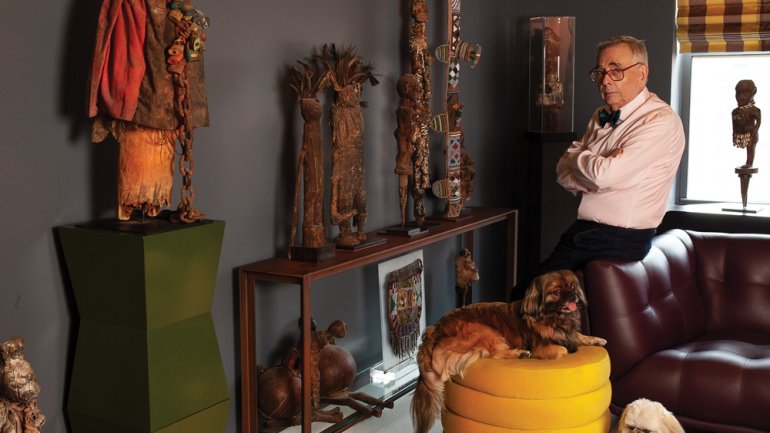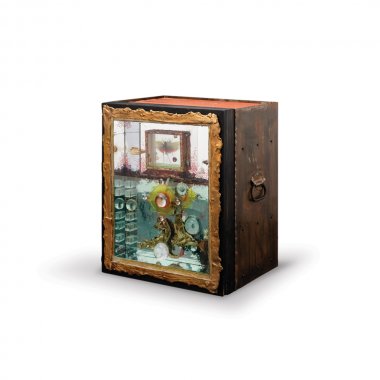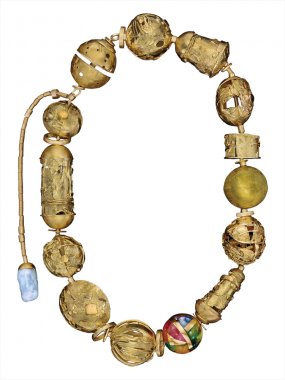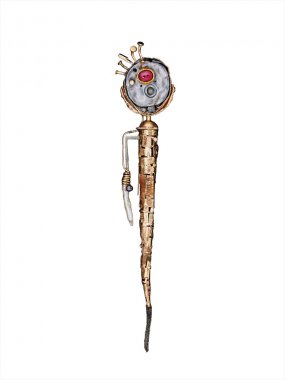Studio Synthesis
Studio Synthesis
William Harper will answer any question about his delicate, complex bejeweled creations but one: “How long did it take to make?”
That’s a query that the genial artist says will “absolutely shut me down.”
“So much of art is thinking,” he explains, speaking by phone from his longtime home and studio, a three-bedroom apartment in Manhattan that he shares with his husband, Bill Benjamin-Harper. “It is the conceptual process we have to go through, and it is conceptualization that makes a fine artist.”
For more than 50 years, Harper, 75, has been putting mind and body into jewelry, sculpture, and paintings that have never been content to simply dazzle, to be only about the material – though his pieces are also about those things. A glimmering sculpture that resembles a brooch might express a synthesis of thought about the saints and the self, such as his self-portrait as the Archangel Michael. A strand of luminous gold and enamel beads can describe Harper’s imaginative mashup of West African Ashanti culture, with elements that resemble shields, alongside the almost microscopically delicate cloisonné of Fabergé.
His work as a goldsmith, enamelist, and painter reflects his love of surface beauty and his restless imagination, which have never been the product of a clock-watching mindset.
“I don’t keep track of time – I might be working on four to six pieces at once,” he says. “And I find just when I’m ready to go to sleep, that’s a very rich time for my imagination.”
That imagination was fostered during his boyhood on a farm in northern Ohio, where Harper had no playmates until the age of 4, when his brother was born. Looking back, he sees what he calls “extreme isolation.” But in that state, his mind spawned a desire to create – not to draw or color, as most children do, but to craft three-dimensional objects from scraps of colored paper, wood, and any detritus that caught his eye.
“I made things,” he says simply. At first, it was little houses and trucks – later, marionettes. By his teens, he was building sets for school plays.
Habits from early childhood persist. “I don’t draw anything first, I just work,” he says. And found objects – teeth and bones of small animals, shards from a car reflector – make their way into his pieces, alongside precious metals and gems.
“He will use a high-karat gold and fearlessly hammer it,” says Pamela Argentieri, a metalsmith and enamelist who studied under him at the Cleveland Institute of Art in the 1980s. (Harper taught for more than 25 years at various institutions, including Florida State University.) “He’ll incorporate fine enamel, or a baroque pearl, and right next to it he’ll place a piece of broken glass.”
His fearless, unconventional approach has nonetheless led to recognition in some of the world’s most renowned museums. The State Hermitage, the Smithsonian, and the Victoria and Albert Museum have his pieces in their permanent collections, and his enamelwork is mentioned alongside that of Fabergé and Lalique. Last winter, the Metropolitan Museum of Art included a brooch in its exhibition “Jewelry: The Body Transformed.” (He modestly places such honors in a larger context; when it comes to enameling and metalsmithing, “I’m a big fish in a small pond. When it comes to all of art, though, I’m a guppy.”) And last spring, his alma mater opened “The Beautiful & The Grotesque,” a 20-year retrospective of his work.
The title speaks to the dichotomy in his work, a recurring theme: high with low, or precious materials with unexpected, sometimes startling, organic objects such as raccoon penis bones. His recent pieces include sculpture inspired by myths and religions and painted books that unfold like Japanese screens.
Harper graduated from the Cleveland Institute of Art in 1966. His mentors included master enamelists and jewelers John Paul Miller and Kenneth Bates, who taught there for decades. Just as important was the school’s location, which at the time was across the street from the Cleveland Museum of Art. He says that the museum placed the decorative arts on the same level as painting and sculpture, which profoundly influenced him.
In the next decade, Harper’s career took off. His 1973 book, Step-by-Step Enameling, sold 100,000 copies. His jewelry was exhibited in regional museums, and in 1978, the Renwick Gallery of the Smithsonian presented a solo exhibition of his work. He won a National Endowment for the Arts fellowship the same year.
Throughout his life, he has dealt with certain unusual gifts – synesthesia, which in his case manifests as “hearing” color – as well as challenges. In 1990, both of his retinas simultaneously detached, causing temporary blindness – something about which he’d had an inexplicable premonition for years, mostly in his dreams or, more accurately, nightmares. He had created a piece in 1986 that he titled The Temptation of St. Anthony as the Artist, depicting the saint of lost items with a single eye. He couldn’t have said why at the time, he notes.
After multiple treatments, vision returned to his right eye, but his left was rendered useless. In the short term, he abandoned the painstaking jewelry work for several years to paint on large canvases. Later, he saw that he had incorporated a single eye in some self- portraits – in the decade before he actually permanently lost vision in one eye.
Argentieri, his former student at CIA, recently visited Harper and saw the grand abstract paintings that hang in his apartment.
“It’s incredible that someone who painted those also could create the delicate work he does in his jewelry,” says Argentieri. “I have two good eyes, and sometimes by the end of the day I struggle. But he has this intensity, which he has had all these years. And he’s going for perfection.”
The intensity, and his productivity, have not waned. Harper has created 28 new pieces over the past three years, including jewelry. As he says, though: “My sales don’t occur all that often, and it takes a brave woman with a strong personality to wear my jewelry. She’ll make the jewelry the important part of the ensemble, and the dress will play second fiddle.”
He says the most conservative piece he ever made was a ceremonial collar that was commissioned in 1982 for then-president of Yale University A. Bartlett Giamatti. The previous presidential collar, made by Tiffany & Co. in 1905, had been stolen three years earlier. Harper crafted the new collar of gold, fine and sterling silver, glass, and cloisonné.
But after Harper proved to himself that he could do that kind of work, he felt no need to do so again.
“I’m improvisational,” he says, noting influences from music, world cultures, mythology, and, in the past, artist-heroes such as Jasper Johns and Cy Twombly. “I make the work for myself. If other people don’t like it, that’s fine.”
At this stage of his life, when some contemporaries consider retirement, he has no intention of cutting back. Though he recently has recovered from neck surgery and sometimes has a slight tremor in his hand, Harper has always been about transcending physical limitations.
His proudest achievement? “I’ve been able to establish a style that anyone who knows modern, contemporary jewelry can see and know that it is mine.”




